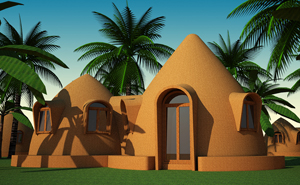
This is a call for assistance from a librarian who can help find a book on how to make do-it-yourself soil stabilizers for natural home builders. About two years ago I published a blog post titled DIY Soil Stabilizer Recipe that has received quite a few comments. Now it’s time to take things to the next level.
The basic soil stabilizer directions in the blog post were kindly shared by a reader who goes by “RB”. It turns out however the process is too vague and complex for most readers. Obviously lots of people would like detailed, step by step, cookbook style DIY directions. Most likely there are some obscure technical books somewhere on how to make soil stabilizers using commonly available natural materials. That’s probably where the owners of soil stabilizer companies got their information. Any librarians out there who can tap into interlibrary loans and find a book like this? Again, the main thing is to find simple directions for making small scale batches of soil stabilizer that don’t require chemistry and industrial engineering degrees to understand.
There are numerous other recipes on my Geopolymer House Blog that might work for some. https://geopolymerhouses.wordpress.com/ Note, I gave up on maintaining that blog a few years ago and so I no longer respond to questions on that site. There is a wealth of free information on the Geopolymer House Blog. One of the most interesting stories is about Professor Joseph Davidovits who believes he has discovered how the Great Pyramids were built with geopolymer. The video in that blog post shows the whole process in a clearly understandable way.
This simple method could still be used today. Combine Davidovits’ recipe with modern machinery like a tractor and pneumatic tamper and it’s feasible to build stone structures efficiently without a large work force. (You could do everything by hand, of course. I’m talking about commercial prospects.) That was the inspiration behind my award winning Stone Dome design proposal. The end product is actual stone, not just something ‘hard as rock’. It would be fire and rot proof, bullet resistant (probably bulletproof at some point after it gains hardness), totally waterproof obviously, and could possibly last thousands of years.

I have been really impressed by going through this awesome blog & It has very important information about building new home. Thank you and please keep posting such type of blog.
Your geopolymer house blog prompted me to do an intensive study of geopolymers last year. Making them is pretty fun.
Geopolymer-ish soil stabilization actually quite easy: substitute sodium silicate (waterglass) for half of the water. This works with all soils. To make it even better, before mixing with the soil add 1/4 the weight of liquid in sodium hydroxide pellets into the liquid. It gets even better if you add any stone dust, mile tailings, fly ash, or blast furnace slag–whatever’s a locally-available waste material. If you can, let it set covered with plastic for at least three days before driving over it.
Obviously this isn’t cheap unless you can get the chemicals in bulk, but it works. Cost is the biggest problem with geopolymers. You can’t buy sodium silicate for anywhere near the low price of portland cement.
Thanks for contributing. This provides one more possible solution.